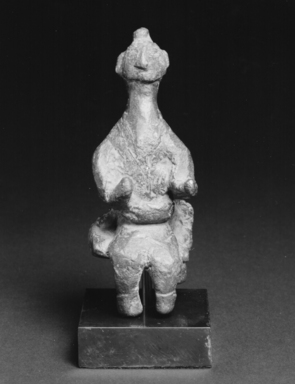
Medium: Bronze
Geograhical Locations:
Dates:4th–6th century
Dimensions: 4 11/16 × 1 3/4 × 1 9/16 in. (11.9 × 4.5 × 4.0 cm)
Collections:
Accession Number: 2021.18.1
Image: CUR.2021.18.1_front.jpg,
Catalogue Description: Seated male figure, possibly a Buddha, with both hands raised at waist height and legs pendant. The figure is seated on a straight-backed chair with legs pendant in a style usually associated with the West. Figure wears a small cap, topknot, or Buddha's cranial protrusion (ushnisha). He is dressed in a kimono-type shirt with waistband. Suggestion of trouser hems in lines across legs. Object is cast with clay core which is visible in the back, which is cast as hollow. TL testing of the object dates the object to the 4th - 6th century, C.E. Figural bronze images are extremely unusual from such an early date, but the figure is in a style similar to clay figures from that period and somewhat earlier. If this is to be read as a Buddha then it is extremely early, dating to the dawn of Buddhism in Korea. Also unusual is the representation of the chair: while Indian Buddha images were occasionally shown seated with legs pendant in what's often called "European style," Korean Buddhas are rarely shown in this posture and then even more rarely on thrones with high backs. Also rare is the high tin content of the bronze alloy. Most early Korean bronzes are high copper content.